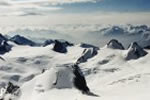 |
 |
 |
 |
 |
 |

Ozone Layer
The Ozone layer is a layer in the stratosphere which protects the Earth from the harmful effects of ultra-violet radiation from space. Discussion about the Ozone Layer became popular when, in 1984, it was discovered that above Antarctica there was a hole in the layer. This was not expected and started scientists on a search to discover why the hole had appeared, and what had caused it.
For ten or more years before the discovery, scientists had been warning that the use of chlorofluorocarbons ( cfc's ) in products that discharged them into the atmosphere could cause serious damage to the Ozone layer, but it was difficult to prove. The chemical companies which had most to lose if cfc's were banned mounted a strong denial of the suggestion and insisted that cfc's were quite safe, so very little was done to reduce their use.
In October 1987 scientists were surprised again when the hole over Antarctica reached the same size as the USA. This increase in size led some scientists to demand immediate action to stop cfc's being used world wide.
However, there is a long delay between cfc's being released into the air, and their arrival in the stratosphere. It can take ten years for the gasses to reach the stratosphere, and another one hundred years before they are naturally destroyed. This means that we may have to live with the consequences of past pollution for many years to come.
Apart from cfc's, which are now used far less frequently in the developed world than they used to be, two other 'greenhouse' gasses that have a bad effect on ozone. These are nitrous oxide and methane. Nitrous Oxide breaks down and destroys ozone as it goes, and methane actually creates more ozone, but in the wrong part of the atmosphere. The methane generates more ozone in the tropopause, which is below the stratosphere, and this layer can hide the holes in the stratosphere above it.
Why should we be bothered about the ozone layer anyway ? Well, the main importance of Ozone is that it acts like a sunblock, filtering out the dangerous ultra-violet rays from the sun. Humans and animals exposed to excessive uv light can develop cancers, their skin ages more quickly and their immune systems are reduced.
Crops also seem to be damaged by extra uv. Some forms of soya bean, an increasingly important crop, have suffered a 25 percent decrease in yield when their exposure to uv B rays was increased by 25 percent.
In the seas it has been found that phytoplankton, the foundation of the ocean food chain, are vulnerable to high exposure to uv rays, as are some fish larvae. Since the human population acquires much of it's food ( especially protein from fish) from the oceans, damage to the phytoplankton might result in a massive reduction in fish stocks and the loss of an important source of food for us.
Finally, and possibly most worrying is the possibility that in the future the ozone layer will start to let very harmful uv-C rays reach the surface of the Earth. At the moment the layer stops all uv-c from reaching us. We know that uv-C can alter and destroy DNA and proteins. We can only guess at the consequences for the human race if our DNA was exposed to uv-c for long periods.
We value
your ideas and suggestions. Please contact the
maintainer of this site.
This page
can be found at: http://www.geography-site.co.uk
Last
update to this statement was on: 8th April 2003
© Copyright Geography Site